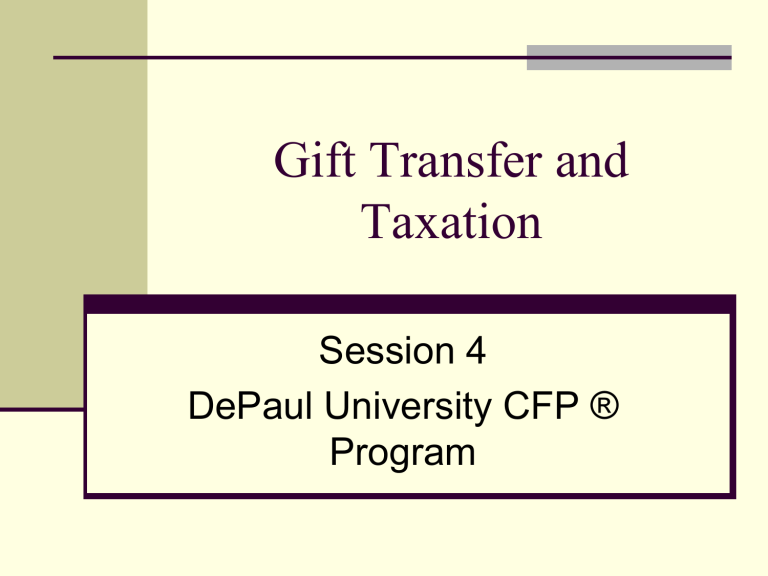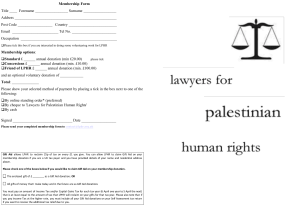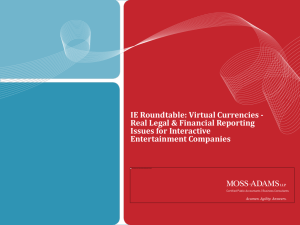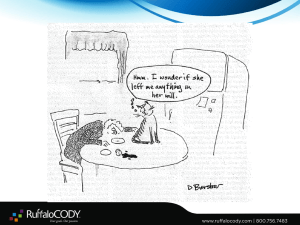Gift Transfer and Taxation

Gift Transfer and
Taxation
Session 4
DePaul University CFP ®
Program
What is a “Gift?”
According to the IRS, a “gift” is any transfer to an individual, either directly or indirectly, where full consideration (measured in money or money's worth) is not received in return.
Often called a “gratuitous transfer”
DePaul University All rights reserved.
2
Lifetime Gifting
Lifetime (inter vivos) gifting is the transfer of property for less than fair market value during the lifetime of the transferor. For a gift to be valid:
The donor must be capable of transferring the gift property
The donee (recipient) must be capable of accepting the gift
The gift must be delivered to the donee or donee’s agent
Donative intent not requirement per federal gift tax
DePaul University All rights reserved.
3
Completed and Incomplete Gifts
For federal gift tax (and certain tax exemptions) to apply, a gift must be a completed transfer.
A completed gift means that the donor gives up:
All control over the gifted property
The right to take back (revoke) the gifted property.
Examples:
Don gives Ron his summer home, but pursuant to a contract allowing Don to live there every August. This is not a completed gift because Don retains some control.
Cash gifts deemed complete when funds clear donor’s bank account
DePaul University All rights reserved.
4
Question 4-1
Aunt Minerva sends a check for $500 to her favorite grandniece, Melanie. The check is a gift for Melanie’s fourteenth birthday. At what point, if any, is Aunt
Minerva’s gift treated as a completed gift?
A.
B.
C.
D.
As of the date Aunt Minerva writes on the check.
When Melanie (or her parent) deposits Aunt Minerva’s check in the bank.
When the bank clears the funds.
When Melanie reaches the age of majority as defined in her domicile state.
DePaul University All rights reserved.
5
Another Incomplete Gift Example
Al, a college student is about to drop out of school due to a lack of funds. His Uncle Max writes a check to his nephew for the sum of $15,000, enough to pay for tuition, books and lodging for one semester. Uncle Max intends this to be a gift.
Sadly, Uncle Max dies suddenly before the Al is able to cash the check. The gift is arguably incomplete and the $15,000 may be treated as part of Uncle
Max’s estate.
DePaul University All rights reserved.
6
Are Gifts To Children Completed
Gifts?
If you put a child’s name on the deed to your house, you have made a completed gift at that moment of the full value of your house, or at least the value of the interest you have deeded to your child.
This gift must be reported on a gift tax return.
On the other hand, if you put your child’s name on your bank account, you have made an “incomplete gift” and it will not be completed until and unless the child actually withdraws money from the account to use for his or her own benefit.
When the child does withdraw money, the gift may be reportable.
DePaul University All rights reserved.
7
Major Gifting Considerations
Financial planners must recognize that tax issues are not always the major consideration in gifting. Planners and clients must also consider the client’s:
Current and future cash flows
Emotional comfort over parting with assets and their corresponding income
Client may feel insecure, or
Client may enjoy seeing children, grandchildren enjoy gifted property
Estate tax exposure, if any
DePaul University All rights reserved.
8
Gifting Techniques
In addition to direct gifts of cash or property, gifts can be made by:
Forgiving a debt
Loans at below market interest rates
Assigning ownership of a life insurance policy
Lifetime transfers to trusts
DePaul University All rights reserved.
9
Question 4-2
Which of the situations below is most likely to demonstrate a gift?
A. Joyce transfers her business to Joe in exchange for an installment note.
B. Jim tells his brother Tim to forget about the rest of the money he is owed from last night’s poker game.
C. When Sue borrows money from her cousin, Lou for a minor operation, Lou charges her current market rate interest.
D. Grandma, age 91, puts her grandson Rob’s name on her checking account so he can pay her rent when she is in the hospital.
DePaul University All rights reserved.
10
Gifting Selection and Strategies
The appropriate gift and donee should be considered per tax and non tax factors:
Highly appreciated property
May be appropriate to give to:
Charity (nontaxable entity)
Lower tax bracket donor
Kiddie tax now applies until child is age 18
Post-death transfer may be better due to step-up in basis. Compare brackets:
If estate tax bracket higher, consider gifting
…..continues….
DePaul University All rights reserved.
11
More Gift Selection Strategies
Property likely to appreciate
Generally appropriate for donor to gift
Further appreciation removed from donor’s estate
Income producing property
Appropriate to gift if:
Donor comfortable relinquishing income
Donee in lower bracket than donor
Beware kiddie tax
DePaul University All rights reserved.
12
Motivations for Gifting
Transferring assets to other persons during lifetime can reduce the taxable estate at the time of death.
Gifts may also be a strategy to transfer tax obligations to another person who is in a lower income tax bracket or to benefit charity and receive a charitable deduction.
For various purposes – such as eligibility for government programs like Medicaid - there is a
“look-back” period to be sure that an individual did not purposefully impoverish himself or herself to become eligible for government assistance.
DePaul University All rights reserved.
13
Gifting Life Insurance
Life insurance
Generally appropriate gift
Gift of replacement value blossoms into face value
Caution: third party owner (when insured, owner and beneficiary are different parties)
Owner may be treated as having made a gift of the proceeds to beneficiary
Example: Dad is insured for $300,000; Mom owns policy; Mom names son as beneficiary. Upon
Dad’s death, Mom is deemed to make gift of
$300,000 to son.
Better arrangement is to hold policy in irrevocable life insurance trust (ILIT)
DePaul University All rights reserved.
14
Is Life Insurance a Present Interest
Gift?
Because life insurance is a financial asset, the recipient (donee) of a life insurance policy could immediately sell it for value.
Thus, a gift of a life insurance policy is a gift of a present interest and eligible for the annual gift tax exclusion
Gift tax value is replacement value, not face value
DePaul University All rights reserved.
15
Present Interest Life Insurance Gift
Example
Barbara gives her whole life insurance policy under which she is the insured to her daughter,
Bonnie. The replacement value (market value) of the policy (consisting of interpolated terminal reserve and unused premium) is $60,000.
Barbara has made a taxable gift of $47,000 her daughter - $60,000 reduced by one annual gift tax exclusion of $13,000
DePaul University All rights reserved.
16
Question 4-3
Regarding transfers of life insurance:
A.
B.
C.
D.
Gifts of life insurance are logically future interest gifts because they generally make no distributions until the death of the insured.
Charitable organizations generally may not accept gifts of life insurance policies.
A transfer of a life insurance policy to a revocable trust is a gift.
Gifts of life insurance are present interest gifts because policy owners may transfer their rights in the policy.
DePaul University All rights reserved.
17
More Gift Selection Strategies
Depreciating property
Generally unwise to gift until the donor has claimed all available depreciation deductions
Appropriate to gift FULLY depreciated property
Loss property/below basis property
More appropriate to sell property, claim the tax loss, then gift net proceeds
Out-of-state real property (real estate)
Appropriate to gift in order to avoid ancillary probate
Consider transfer in trust to benefit multiple family members
DePaul University All rights reserved.
18
Annual Gift Tax Exclusion for Present Interest Gifts
The gift tax does not apply to the first $13,000 (2012) of money or property transferred to each donee if the gift is of a present interest.
$13,000 indexed from $10,000 base in $1,000 increments
Present interest means that donee has immediate right to use/enjoy/receive income from the gift.
Donor must relinquish ALL control
Future interest gifts (where donee’s interest is delayed) are not eligible for annual gift tax exclusion
DePaul University All rights reserved.
19
Present and Future Interest Gift
Examples
Present interest gift example:
In 2012, Grandma gives grandson stock worth
$50,000.
Taxable gift amount = $37,000
Exempt gift = $13,000
Future interest gift example :
John Sr. gives his son, John Jr., the right to income from his commercial building and his grandson, John III title to the building following the death of John Jr.
John III has no present interest so no part of the gift is eligible for the annual gift tax exclusion
DePaul University All rights reserved.
20
The Annual Gift Tax Exclusion
At its 1932 inception, the exclusion was fixed at $5,000 dollars per donee per year --
"sufficiently large to cover in most cases wedding and Christmas gifts and occasional gifts of relatively small amounts."
S.REP. No. 665, 72d Cong., 1st Sess. 41 (1932)
Its stated purpose was to “obviate the necessity of keeping an account of and reporting numerous small gifts.”
DePaul University All rights reserved.
21
Exceptions to the Present Interest Rule
There are several exceptions to the present interest rule, including:
Section 529 college plans
Donor may claim up to 5 times annual gift tax exclusion in initial gift year
Exclusions prorated if donor does not live five years following initial gift
Transfers to 2503(c) trusts
Statutory exception
Annual transfers to trusts having Crummey provisions
Beneficiary has limited current access to transferred property
DePaul University All rights reserved.
22
Gifts to Non-Citizen Spouses
If the donee spouse is a citizen, any qualified gifts to him or her during donor’s life are 100% deductible.
If the donee spouse is not a U.S. citizen there is no marital deduction. Instead, there is a “super annual gift tax exclusion” of $139,000.
$139,000 is the 2012 figure indexed for inflation from a
$100,000 base).
In addition, the donor has a $5.12 million exclusion amount to give to anyone without owing federal gift/estate tax.
DePaul University All rights reserved.
23
Question 4-4
What is the maximum amount of the tax-free gift that Brad can give to his wife Monique in 2012 if
Monique is a citizen of France?
A.
B.
C.
D.
Unlimited
$13,000
$139,000
$126,000
DePaul University All rights reserved.
24
History of Annual Gift Tax
Exclusion
Year(s)
Gift Tax Annual Exclusion
Annual Exclusion
1932 – 1938
1939 – 1942
1943 – 1981
1982 – 2001
2002 – 2005
2006 – 2008
2009 – 2012
$5,000
$4,000
$3,000
$10,000
$11,000
$12,000
$13,000
DePaul University All rights reserved.
25
Valuing a Gift
The general rule for valuing a gift for federal gift tax purposes is to use the FMV of the property as of the date of the gift.
DePaul University All rights reserved.
26
Question 4-5
Grandma Emily gave her favorite granddaughter,
Emma, 1,000 common shares in Walkright Shoe Inc. In
1989, Grandma bought the shares for $10,000 when they hit an all-time high trading price of $100 per share.
When Grandma gave the stock to Emma last week, it was trading at $50 per share. Emma quickly sold the stock on a tiny rally at $55 per share. What is the per share gift valuation of the stock?
A.
B.
$10/share
$50/share
C.
D.
$55/share
$100/share
DePaul University All rights reserved.
27
Discounting Valuations
Gifts of interests in certain corporations, partnerships and LLCs, can be discounted due to the lack of control and lack of liquidity that are inherent in such interests.
For example, a gift of a twenty percent (20%) interest in a limited liability company that holds real estate worth $10 million might be entitled to a discount ranging between twenty percent (20%) and thirty-five percent (35%). Assuming a discount of thirty-five (35%), the amount of the reportable gift would be $1,300,000.
DePaul University All rights reserved.
28
Net Gifting
A net gift is a gift where the recipient/donee agrees to pay the gift tax or assume some liability attached to the gifted property.
It is used when the donor has exhausted his/her annual exemption for the year as well as the gift tax credit.
Because the donee absorbs the gift tax, the gift is actually less than its fair market value and the donee pays less gift tax than would have otherwise accrued .
DePaul University All rights reserved.
29
Net Gifting Situation
It appears that Wanda’s estate will be subject to substantial federal estate tax. Over the years she has already made taxable gifts of well over $5,500,000. She owns an asset worth $1,513,000 and would like to remove that asset and its future appreciation from her estate. She is thinking about gifting the asset to her daughter but does not want to pay the 35% gift tax on
$1,500,000 (the FMV of the gift reduced by one annual gift tax exclusion of $13.000) which amounts to
$525,000.
…….continued
DePaul University All rights reserved.
30
Net Gifting Example Continues
( continued )
Net gifting addresses Wanda’s objectives.
As a condition of the gift, her daughter would be required to pay the gift tax
If her daughter pays the tax, it is less than the
$525,000 for which Wanda would have been liable
The donee’s gift is calculated by dividing the donor’s gift tax liability by 1 plus the gift tax rate.
$525,000/1.35 =$338,889
DePaul University All rights reserved.
31
Reporting Net Gifts for Estate Tax
Although the donor does not pay the transfer tax on a net gift, the tax paid by the transferee operates as a credit against any donor’s federal estate tax liability.
In calculating the tax base, the amount of the net gift is added to the taxable estate.
Wanda made a taxable gift of $1,500,000 to her daughter but to calculate the amount of the net gift, the $388,889 tax paid by the daughter is subtracted so the net gift amount is $1,111,111.
DePaul University All rights reserved.
32
Question 4-6
Which of the following statements regarding the net gifting technique is true?
A.
It may be elected for any gifting in excess of the annual gift tax exclusion.
B.
C.
D.
The donee pays the same amount of federal gift tax that would otherwise be attributable to the donee.
It is only permitted for post-mortem transfers.
If the amount of gift tax paid exceeds the donor’s basis in the gift, that donor may realize capital gain.
DePaul University All rights reserved.
33
Reverse Gifts
A reverse gift is a strategy to minimize capital gains by transferring low basis property to someone who will or may die soon.
The objective is to utilize the post-death step up in basis to lower capital gains.
The “one-year” rule often collapses this strategy if the donee does not live one year or longer following the transfer.
DePaul University All rights reserved.
34
Reverse Gift Example
Bonnie and Walter Franklin are a married couple. Most of their wealth is in Bonnie’s name. Among Bonnie’s assets is a substantial portfolio of stocks having a very low basis.
Recently, Walter got bad news from the doctor who predicts Walter’s life expectancy at under two years. If
Bonnie transfers the stocks to Walter (free of gift tax because it is a spousal transfer), then Walter dies and leaves her the stock, Bonnie enjoys a stepped up basis on the portfolio.
….continued
DePaul University All rights reserved.
35
Reverse Gift Trap
( continued )
If Walter does not live for at least one year following the reregistration of the stocks into his name, the transfer will be “reversed.”
It will not be included it Walter’s estate
Bonnie will be deemed to continue to own the stocks.
Note: Donee must be under no obligation to transfer back the gifted property.
DePaul University All rights reserved.
36
Donee Basis for Appreciated Gifted
Property
For property gifted with a FMV greater than the donor’s basis, the donee assumes the donor’s adjusted basis.
Known as “carry over basis”
Donee increases carry-over basis to reflect gift tax actually paid on the appreciation of gifted property
Basis increase =
(FMV-Basis)/(Taxable FMV) x Tax Paid
DePaul University All rights reserved.
37
Example of Basis Adjustment
Example: Paulette gives her son, Paul, stock with a FMV of $60,000. Paulette, who had originally acquired the stock for $20,000, paid $15,000 in federal gift tax at the time of the gift. We can calculate Paul’s adjusted basis as follows:
$20,000 + $40,000 x $15,000 =$30,000
$60,000
DePaul University All rights reserved.
38
Donee Basis for Loss Property
Generally, donee’s basis will be FMV
Where the donee's selling price is higher than the asset's value on the date of the gift but lower than the donor's cost basis, the recipient will have neither a gain nor a loss.
Where the donee's selling price is higher than donor's basis, the donee measures gain using the donor’s basis
DePaul University All rights reserved.
39
Donee Basis for Loss Property
Example: Dad bought ABC stock for $50,000. Stock drops to $30,000 and Dad gives it to daughter
If daughter sells ABC for between $30,000 and
$50,000 she recognizes neither gain nor loss.
If daughter sells ABC for less than $30,000, she recognizes loss (sale at $20,000 = $10,000 loss)
If daughter sells ABC for more than $50,000, she recognizes gain (sale at $60,000 = $10,000 gain)
Donor’s holding period “tacks on” to donee’s holding period
DePaul University All rights reserved.
40
Question 4-7
Grandma Emily gave her favorite granddaughter, Emma,
1,000 common shares in Walkright Shoe Inc. In 1989,
Grandma bought the shares for $10,000 when they hit an alltime high trading price of $100 per share. When Grandma gave the stock to Emma last week, it was trading at $50 per share. Emma quickly sold the stock on a tiny rally at $55 per share. What is Emma’s gain/loss?
A. $90,000
B. $50,000 long-term gain
C. $45,000 short-term gain
D. $0
DePaul University All rights reserved.
41
Gift Tax Filing
The Federal Gift Tax Form 709 must be filed when a donor makes:
Gifts of cash or property exceeding $13,000
(2012) to any individual donee (not spouse)
Gift of a terminable interest to a spouse
Gifts of a future interest in any amount
Election to split gifts with a spouse
Form 709 due April 15 of year following gift
DePaul University All rights reserved.
42
When A Gift Tax Return is NOT Reqired
Amounts given to (or for the use of) political organizations
Exempt gifts for tuition or medical expenses
(discussed below).
The following gifts made to charities:
Your entire interest in property (i.e., not a split-interest transfer)
A qualified conservation easement
DePaul University All rights reserved.
43
Gift Tax Isn’t Income Tax
Making a gift or leaving your estate to heirs does not ordinarily affect a taxpayer’s federal income tax.
A taxpayer cannot deduct the value of gifts other than gifts that are deductible charitable contributions.
The recipient of a gift from any donor other than an employer does not include the value of such gift in gross income.
DePaul University All rights reserved.
44
Gifts and Income Tax
A taxpayer can’t avoid paying income tax by calling something a gift when it isn’t.
For example, a “gift” received in exchange for services or some other consideration isn’t a gift.
The recipient of a gift in the form of income-producing property must report any income earned after the gift.
Foreign donor.
Certain large gifts or bequests from certain foreign persons must be reported.
DePaul University All rights reserved.
45
Gift Tax Lifetime Exclusion
Each US citizen has a gift tax credit (2012) of
$1,772,800 which is the tax on $5,120,000
This is in addition to the annual gift tax exclusion
If, in any year, the donor makes a taxable gift, the tax due reduces his credit.
When lifetime taxable gifts exceed $5.12 million, then donor pays gift tax out of pocket
DePaul University All rights reserved.
46
Gift Splitting By Spouses
If a married individual makes a gift to a third party, the gift can be considered as made one-half by each spouse. This is known as gift splitting.
Both spouses must consent to split the gift.
Allows use of nongifting spouse’s annual
exclusion.
In 2012 a married couple can give one donee
$26,000 tax-free.
Election to split gifts is made on the Form 709 – if only one spouse makes transfers then non-gifting spouse only signs consent
DePaul University All rights reserved.
47
Split Gift Example Within Exclusion
Limits
Rob and Laura Peters, a married couple, gift $26,000 worth of corporate bonds to their son, Richie. The bonds were transferred from Rob’s individually-owned brokerage account. No other gifts were made.
If the Peters live in a common law state:
Rob files the gift tax return and Laura signs the consent line
If the Peters live in a community property state:
Gift is automatically deemed split
No gift tax return is required
DePaul University All rights reserved.
48
Split Gift Example
Exceeding Exclusion Limits
Ralph and Alice Hampton, a married couple, gift
$56,000 worth of mutual fund shares to their daughter,
Linda. The stock is transferred from Laura’s individual account. No other gifts were made.
Alice files a 709 and Ralph signs consent
The first $26,000 is non-taxable (two $13,000 annual gift tax exclusions)
The remaining $30,000 is deemed gifted one-half from Alice and one-half from Ralph
Alice and Ralph each use up $15,000 of their
$5.12 million dollar exemption equivalent
DePaul University All rights reserved.
49
Question 4-7
For which of the following gifts is it most effective to elect gift splitting?
A.
Nate, a married taxpayer pays tuition to the college his daughter Natalie currently attends.
B.
C.
D.
Ellen transfers ownership of $100,000 in stock certificates to her husband, Alfred.
Kyle, a married taxpayer gives $24,000 to his son,
Kirk, for expenses after Kirk loses his job.
Irving and Sheila Barker, married taxpayer give
$100,000 to the University of Illinois (where they met)
DePaul University All rights reserved.
50
Gift Through Establishing Joint
Tenancy
In general, transferring property from individual ownership to joint tenancy creates a gift of one half interest to the new joint tenant.
Exception for joint tenancy bank accounts where the gift occurs when donee joint tenant withdraws funds for donee’s benefit
DePaul University All rights reserved.
51
Gifting U. S. Savings Bonds
(EE Bonds)
If an individual furnishing the entire purchase price of a U.S. Savings Bond (Series EE Bond) registers the bond in two names, no occurs until the bond is redeemed.
If the buyer redeems the bond (as an individual), no gift occurs
Joint registration can be used as a will substitute
DePaul University All rights reserved.
52
Gifts Exempt from Gift Tax
The following types of gifts are not subject to gift tax (gift tax deductible), regardless of amount:
Gifts of non-terminable interests to U.S. citizen spouses
Gifts to bona fide charities
Gifts of educational expenses on behalf of any student if paid directly to the educational institution
Gifts of medical expenses on behalf of any patient if paid directly to the medical provider
Gifts to political parties
DePaul University All rights reserved.
53
Exempt Gift Examples
Example 1.
You give your niece a cash gift of $8,000. It is your only gift to her this year. The gift is not a taxable gift because it is not more than the $13,000 annual exclusion.
Example 2.
You pay the $15,000 college tuition of your friend directly to his college. Because the payment qualifies for the educational exclusion, the gift is not a taxable gift.
Example 3.
You give $25,000 to your 25-year-old daughter. The first $13,000 of your gift is not subject to the gift tax because of the annual exclusion. The remaining
$12,000 is a taxable gift and must be reported by filing a
Form 709
DePaul University All rights reserved.
54








